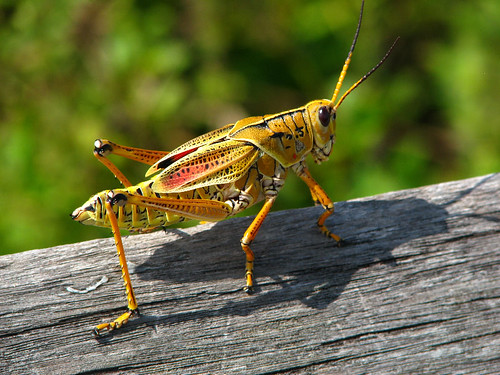Fortunately, these large and colorful grasshoppers are not harmful to people, but they are harmful to many predators that eat them. The vivid coloration of the lubbers (either black with a red stripe, or orange) is a warning from the lubber to the predator that they are poisonous or downright disgusting to eat. These toxins are from the plants that they ingest in order to assimilate toxins. However, if the colors do not come off as toxic to the predator, the lubber will secrete a toxic foam and hiss. On top of those toxic things, the lubber could also regurgitate a brown liquid in defense as well. These chemicals may kill smaller predators and will ward off the bigger predators, unless they can handle the toxins.
Lubbers travel in vast numbers and destroy many plants that are in the Everglades. They devour plants as they move along and are seen as a hazard to the plant life in the Everglades. The lubbers eat a lot of orchids, which then cause the orchids to become more endangered. A lot of the farmers try to keep the lubbers away from their plants, but there is not a lot of ways to keep the lubbers away.


Are these some of the photos you took while we were there? They look awesome! The hissing still upsets me, greatly.
ReplyDeleteDid you notice while you were there the TONS of them all over the pond apple tree? I wonder if they like the sweetness of the fruits or leaves of that tree.
Those Lubbers were the coolest thing ever. They seemed to come in such a variety of colors and it looked as if even if two were the same color their patterns weren't the same. It makes you wonder if maybe each lubber has a unique pattern like zebras and their stripes.
ReplyDeleteOne of my favorite things about the lubbers is their intricate patterns and vibrant colors. I also find it extremely interesting that the smaller juvenile lubbers are black yellow and red and once they reach adulthood/sexual maturity, they change colors in order to attract a mate. That evolutionary trait that developed over time is extremely intriguing to me. I also find it amazing how powerful these small creatures actually are. They may be small but those legs can really propel them far.
ReplyDeleteWe saw our fair share of lubbers in week 2! They were everywhere, and just when you thought you spotted them all, there were more hidden under leaves or on branches. It's so strange that they have such bright colors and different color patterns, yet they blend in so perfectly with their background. This was the first time I've ever seen a lubber and they are very interesting insects.
ReplyDeleteThis was my first time seeing a lubber and when I seen it, it freaked me out because of how big it was. However, i have to agree with macie about their colors they are very pretty to look at I just wonder why they are so colorful and not just green.
ReplyDeleteThis is crazy I have lived in FL my whole life and never new these were called lubbers. We always called them locusts.Found a bunch of baby red and black ones on my wife's greatgrandmothers tree and was looking for what exactly they were. Learn something new everyday.
ReplyDelete